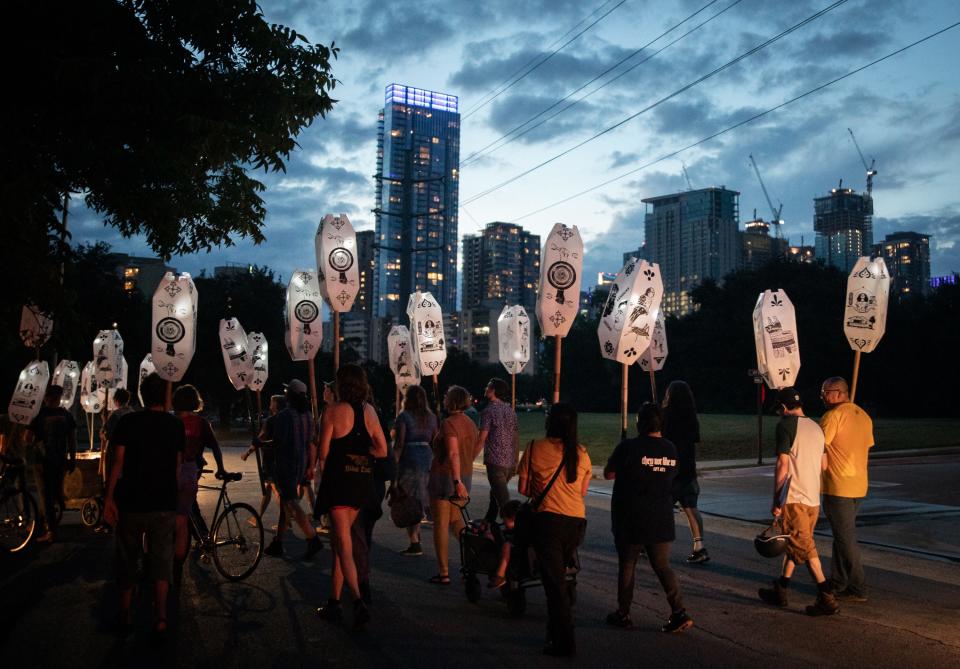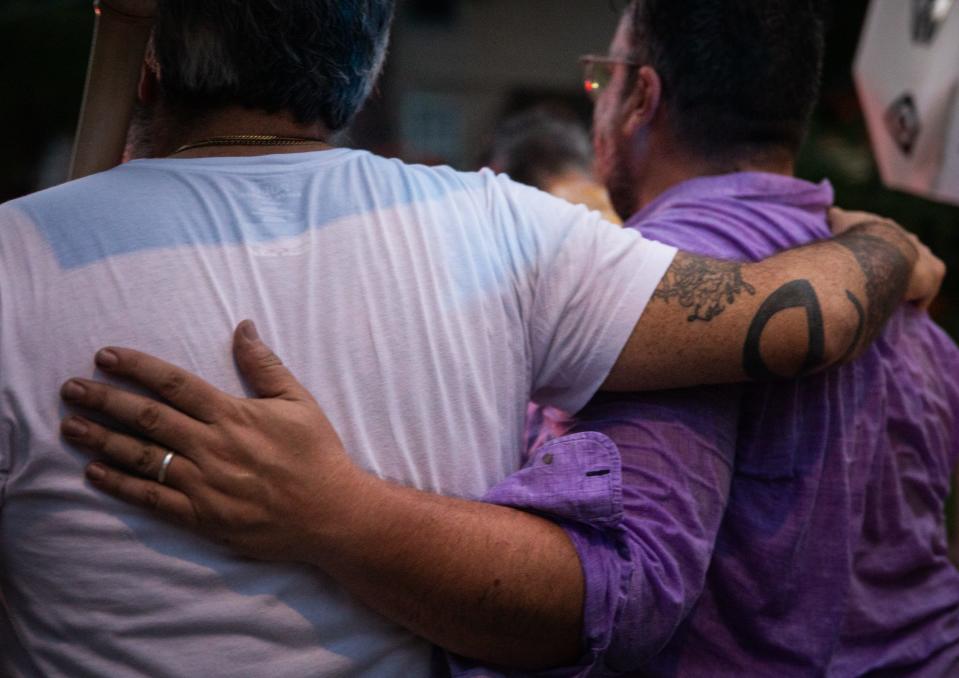In East Austin, Colombian American sculptor uses art procession to tackle displacement
To make sense of change and displacement in East Austin, artist Juan Christian “J.C.” King turned to sound.
The Colombian American sculptor and self-described "public sound" artist built a cart somewhat reminiscent of a picó, a mobile music machine of stacked speakers that brings cumbias to neighborhood corners in Colombia.
But King’s machine produced more somber and fleeting sounds, those often confined to the memories of long-standing East Austinites who remember previous versions of their neighborhoods. King, who grew up off East Cesar Chavez Street, interviewed 60 such residents (some displaced, some still in place) to make sense of what sounds the neighborhood had lost and what sounds he could reintroduce.
On Thursday evening, as the longest day of the year came to an end, King’s music cart was front and center in the artist’s East Austin Ghost Procession. The music machine produced a sound reminiscent of chimes, scattered with noises of children playing, parrot chatter (from the somewhat infamous monk parakeets) and cricket chirps. The three dozen or so participants carried screen-printed lanterns with images of other memories, like bungalow homes, Our Lady of Guadalupe Catholic Church, barbecue gatherings and people speaking Spanish.
“The intention from a broad scope was taking a memory and taking it through the streets that created it," King said. “Like a ghost,” he added, that for a moment revives what is gone.

The procession began at the Pan American Neighborhood Park, where children and adults alike interacted with a miniature 3D-printed representation of East Austin atop the music cart. King had painted some of the buildings black to represent demolition and kept large empty spaces to reference the large tracts razed for redevelopment. Each building, when pressed on, added a different sound to the music, evoking squeals and chuckles.
Many of the participants were an artistic crowd. The number of leg tattoos appeared to far outnumber the number of participants over the age of 50.
Many attendants, like Khattie “KhattieQ” Quiñones, 46, said they attended for the sake of visibility. Though not originally from East Austin, she has lived in Austin for three decades, and said she thought the process was “a way of communicating — we’re still here: Hispanics, artists, Black people.”
As she walked down Chicon Street toward East Cesar Chavez carrying her lantern, Quiñones reflected on what she hoped the community members observing the procession would understand from it.
“A peaceful quality, a sense of community,” she said. “I hope they’re moved by the sounds, that they wonder what we’re doing.”
The sky grew dark by the time the procession arrived on East Cesar Chavez. The lanterns began to glow. Behind the procession, a few westbound cars honked.

A group of mourners in matching shirts watched from outside Mission Funeral Home, and across the street a few restaurantgoers leaned against the facade of an upscale Korean eatery.
Three blocks later, on Comal Street, neighborhood resident Silvia Alvarado watched the procession with her mouth agape.
“It’s something about languages,” she said, in reference to one of the designs on the lanterns.
When informed by the American-Statesman of the procession’s intent, Alvarado said she wouldn’t have realized that.
“That’s not what I got from that,” said Alvarado, who has lived on Rainey Street and in central East Austin since she was born in 1962. She began to talk about how few neighbors remained and how high her property taxes were.
The procession quickly passed by.

The artist’s fascination processing change
King grew up around East Cesar Chavez in the 1980s and ’90s. As a teen, he reveled in the neighborhood’s hardcore music scene. East Austin is where he first performed as a musician, where he developed a fascination with "sound in public places."
But King hasn’t lived in East Austin since 2018, the year after he moved back to Austin after living in New York for a few years. Rent was too high. So too was the price of a house.
Besides, the neighborhood now is not the neighborhood he called home. King can recall the changes that most struck him: the closing of the El Milagro tortilla factory on East Seventh, the paving of the rocky segments of East Fifth.
“The city I grew up in, it feels like it’s buried underneath this one,” he said.
Reflecting on this made King want to know what others remembered, what elements of East Austin others missed and what elements they thought had withstood its transformation.

The recurring details are what made it into his art installation. In evoking the past, King said he hoped to bring together people who have been dispersed.
“Things are going to change and there’s nothing we can do about this, but my hope … is that through our efforts we can maintain our networks and still function as a community,” King said.
How to remember?
Procession attendee Joel Cortez, 47, said the art made him wonder what the best way was to recall old East Austin.
Cortez, a state worker and musician who collaborates with King, was there in part to eulogize the East Side he had known. He had moved there from Houston as a 15-year-old in 1996 and become a punk. He had stayed in the neighborhood to start a family in the early 2000s, a couple of blocks from the procession’s route on Comal.
He had lived there as long as he could. But after he was evicted in 2010, Cortez said he has looked elsewhere in the city for a lower cost of living.
Cortez said he participated in the procession because he thought it was important for Austin to reflect more on its past.
“Austin has historically not been a sentimental place,” Cortez said, pointing to the city’s quick change and embrace of the new.
Maybe, he wondered, that could change.
This article originally appeared on Austin American-Statesman: Experimental art procession highlights displacement in East Austin

